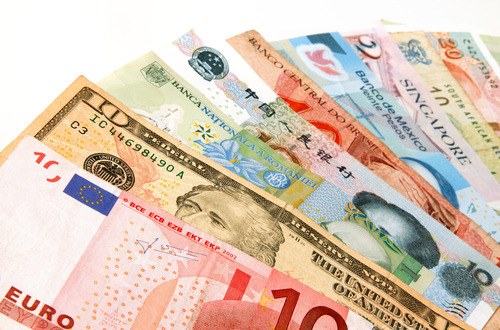If you’re planning on growing your business, it’s possible you’ve thought about whether you could potentially sell your goods or services to people in other countries.
But if those customers want to pay you in their home country’s currency rather than in yours (and you’re happy to deal with the unpredictability of exchange rates to accommodate this) how do you manage these types of foreign sales in your accounts?
Why should you allow payment in foreign currencies, and how do you do this?
Overseas customers are usually more inclined to prefer the convenience of paying you in their own currency, so you may want to explore whether you can set your price and invoice them in that currency.
Even if you don’t issue invoices to your customers – for example if you’re trading over the web or via an e-commerce site – you may find it easier to attract customers from outside the UK if they can pay you in their own currency.
In either case, this will mean you’ll need to have a system set up for taking payment in a foreign currency. You can do this by setting up a bank account in your customer’s currency, which may be costly and could prove difficult when it comes to transferring money between that account and your own one.
Alternatively, there are other systems, such as PayPal, which allow you to accept payment in multiple currencies without having to set up a new bank account. PayPal can then translate all your money into pounds sterling as you receive it, no matter what currency your customers actually paid you in. However, they do charge a fee for this service.
Whichever option you choose, remember that you can also now track all of these bank accounts in FreeAgent in their own currencies, making it easier than ever to manage your business finances if you’re working with overseas customers.
Ways to avoid foreign transaction fees when receiving international payments
Opening up a foreign bank account can be costly and difficult. You may need to travel to the country and visit a local branch to fill out paperwork. There also is typically a monthly charge, and maybe even a minimum deposit required. On top of that, you usually receive unfavourable exchange rates on top of any foreign transaction fees.
Fortunately, new fintech challengers have been entering the market to reduce the costs of international payments and make it easier for businesses to manage money across borders. One player that’s focused specifically on international money transfers is TransferWise. They offer a free, online multi-currency account that comes with unique account details for the US, Eurozone, UK and Australia. You can use them to receive payments in US dollars, euros, pounds and Australian dollars for free. So if you’re a UK business selling in Europe, you can sell in euros, use your European bank details to get paid, and then convert your earnings into pounds within your TransferWise account. Traditional providers such as the banks or PayPal typically charge a fee to receive foreign payments.
TransferWise will also convert money at the mid-market exchange rate, which can be up to eight times cheaper than your bank. You’ll only ever be charged a small, upfront fee on the value of the transfer. You can manage over 40 currencies within the one login.
Invoicing in a foreign currency
If you’re using an online accounting system, it’s easy to invoice customers in a different currency. You just pick your currency as you set up each customer and the system will then automatically translate your invoice into pounds sterling for inclusion in your year-end accounts.
However, it’s important to remember that if you’re invoicing in a foreign currency you still have to produce accounts for HMRC that are all in pounds sterling, so you’ll have to translate your invoices and the money you receive.
Exchange rates can, and do, fluctuate from month to month and you might find yourself with fewer pounds in your bank account than you planned. But, on the other hand, you might also be lucky and find you’re better off because of exchange rate shifts.
If you’re invoicing in a foreign currency and you’re registered for UK VAT, you also need to show the pounds sterling equivalent of the total amount of VAT of what you’re selling, and the amount of VAT you’re charging, if any, at each different rate. This is because you’ll pay HMRC the VAT in pounds sterling, and show the sterling value in your accounts.
Accounting with multiple foreign currencies
OK, so you’ve done the work and invoiced your customer. What now?
Well, because you’re preparing accounts to submit to the UK authorities, whether that’s Companies House or HMRC or both, these accounts must always be stated in pounds sterling.
In brief, if you buy or sell something in a foreign currency, it’s recorded in your books in sterling, using the exchange rate in force as at the date of the purchase or sale. The exchange rate is governed by financial reporting standards rather than by HMRC, and the standards for small entities are classed as ‘the exchange rate in operation on the date on which the transaction occurred; if the rates do not fluctuate significantly, an average rate for a period may be used as an approximation’.
We believe this means you are permitted to use a published exchange rate, such as those found on xe.com or oanda.com in your accounts rather than the ‘official’ one set by international banks.
When it’s time to prepare your balance sheet, if you have a balance on an account in a foreign currency, that must also be translated into pounds sterling as at the exchange rate in force on the balance sheet date. The foreign currency account might be a bank account in that currency, a PayPal balance in that currency, or money that an overseas customer owed you or that you owed to an overseas supplier.
If you’re selling in a foreign country and working with multiple currencies, make sure you follow the rules and pay the correct amount of tax on the money you owe, or you’ll risk a visit from HMRC and/or the tax office where you’re selling.
If you’re unsure about anything, you should also seek the help of a professional accountant who will be able to help you.
If you’re using an online accounting system, it’s easy to invoice customers in a different currency. You just pick your currency as you set up each customer and the system will then automatically translate your invoice into pounds sterling for inclusion in your year-end accounts. We recommend these top picks of accounting software for small businesses:
Further reading on accounts
Which digital accounts software is right for your small business?





